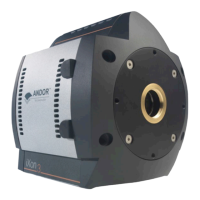Page 70
Appendix
A1.1.2 - Accumulation
Accumulation is the process by which data that have been acquired from a number of similar scans are added together
in computer memory. This results in improved signal to noise ratio.
A1.1.3 - Acquisition
An Acquisition is taken to be the complete data capture process.
A1.1.4 - A/D Conversion
ChargefromtheCCDisinitiallyreadasananaloguesignal,rangingfromzerotothesaturationvalue.A/D
conversion changes the analogue signal to a binary (digital) number which can then be manipulated by the computer.
A1.1.5 - Background
Background is a data acquisition made in darkness. It is made up of xed pattern noise, and any signal due to dark
current.
A1.1.6 - Binning
Binning is a process that allows charge from two or more pixels to be combined on the EMCCD-chip prior to readout.
A1.1.7 - Counts
CountsrefertothedigitizationbytheA/Dconversionandarethebasicunitinwhichdataaredisplayedandprocessed.
Depending on the particular version of the detection device, one count may, for example, be equated with a charge of 10
photoelectrons on a pixel of the CCD.
A1.1.8 - Dark Signal
Darksignal,achargeusuallyexpressedasanumberofelectrons,isproducedbytheowofdarkcurrent
during the exposure time. All CCDs produce a dark current, an actual current that is measurable in (typically tenths
of) milliamps per pixel. The dark signal adds to your measured signal level, and increases the amount of noise in the
measured signal. Since the dark signal varies with temperature, it can cause background values to increase over time.
It also sets a limit on the useful exposure time. Reducing the temperature of the CCD reduces dark signal (typically, for
every7ºCthattemperaturefalls,darksignalhalves).CCDreadoutnoiseislow,andsoasnottocompromisethisbyshot
noise from the dark signal, it is important to cool the detector to reduce the dark signal. If you are using an exposure
timeoflessthanafewseconds,coolingthedetectorbelow0ºCwillgenerallyremovemostoftheshotnoisecausedby
dark signal.

